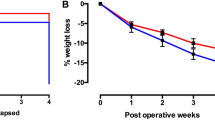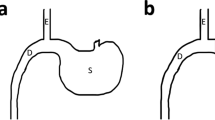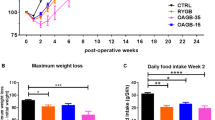Abstract
Objective:
All available treatments directed towards obesity and obesity-related complications are associated with suboptimal effectiveness/invasiveness ratios. Pharmacological, behavioral and lifestyle modification treatments are the least invasive, but also the least effective options, leading to modest weight loss that is difficult to maintain long-term. Gastrointestinal weight loss surgery (GIWLS) is the most effective, leading to >60–70% of excess body weight loss, but also the most invasive treatment available. Sleeve gastrectomy (SGx) and Roux-en-Y gastric bypass (RYGB) are the two most commonly performed GIWLS procedures. The fundamental anatomic difference between SGx and RYGB is that in the former procedure, only the anatomy of the stomach is altered, without surgical reconfiguration of the intestine. Therefore, comparing these two operations provides a unique opportunity to study the ways that different parts of the gastrointestinal (GI) tract contribute to the regulation of physiological processes, such as the regulation of body weight, food intake and metabolism.
Design:
To explore the physiologic mechanisms of the two procedures, we used rodent models of SGx and RYGB to study the effects of these procedures on body weight, food intake and metabolic function.
Results:
Both SGx and RYGB induced a significant weight loss that was sustained over the entire study period. SGx-induced weight loss was slightly lower compared with that observed after RYGB. SGx-induced weight loss primarily resulted from a substantial decrease in food intake and a small increase in locomotor activity. In contrast, rats that underwent RYGB exhibited a substantial increase in non-activity-related (resting) energy expenditure and a modest decrease in nutrient absorption. Additionally, while SGx-treated animals retained their preoperative food preferences, RYGB-treated rats experienced a significant alteration in their food preferences.
Conclusions:
These results indicate a fundamental difference in the mechanisms of weight loss between SGx and RYGB, suggesting that the manipulation of different parts of the GI tract may lead to different physiologic effects. Understanding the differences in the physiologic mechanisms of action of these effective treatment options could help us develop less invasive new treatments against obesity and obesity-related complications.
This is a preview of subscription content, access via your institution
Access options
Subscribe to this journal
Receive 12 print issues and online access
$259.00 per year
only $21.58 per issue
Buy this article
- Purchase on Springer Link
- Instant access to full article PDF
Prices may be subject to local taxes which are calculated during checkout



Similar content being viewed by others
References
Buchwald H . Metabolic surgery: a brief history and perspective. Surg Obes Relat Dis 6: 221–222.
Buchwald H, Avidor Y, Braunwald E, Jensen MD, Pories W, Fahrbach K et al. Bariatric surgery: a systematic review and meta-analysis. JAMA 2004; 292: 1724–1737.
Buchwald H, Estok R, Fahrbach K, Banel D, Sledge I . Trends in mortality in bariatric surgery: a systematic review and meta-analysis. Surgery 2007; 142: 621–632 discussion 632–635.
Sjostrom L, Lindroos AK, Peltonen M, Torgerson J, Bouchard C, Carlsson B et al. Lifestyle, diabetes, and cardiovascular risk factors 10 years after bariatric surgery. N Engl J Med 2004; 351: 2683–2693.
Gagner M, Deitel M, Kalberer TL, Erickson AL, Crosby RD . The Second International Consensus Summit for Sleeve Gastrectomy. March 19–21, 2009. Surg Obes Relat Dis 2009; 5: 476–485.
Brethauer SA, Hammel JP, Schauer PR . Systematic review of sleeve gastrectomy as staging and primary bariatric procedure. Surg Obes Relat Dis 2009; 5: 469–475.
Cottam D, Qureshi FG, Mattar SG, Sharma S, Holover S, Bonanomi G et al. Laparoscopic sleeve gastrectomy as an initial weight-loss procedure for high-risk patients with morbid obesity. Surg Endosc 2006; 20: 859–863.
Weiner RA, Weiner S, Pomhoff I, Jacobi C, Makarewicz W, Weigand G . Laparoscopic sleeve gastrectomy—influence of sleeve size and resected gastric volume. Obes Surg 2007; 17: 1297–1305.
D’Hondt M, Vanneste S, Pottel H, Devriendt D, Van Rooy F, Vansteenkiste F . Laparoscopic sleeve gastrectomy as a single-stage procedure for the treatment of morbid obesity and the resulting quality of life, resolution of comorbidities, food tolerance, and 6-year weight loss. Surg Endosc 2011; 25: 2498–2504.
Mehran A, Koleilat A . Sleeve gastrectomy failure: just when we thought we had the perfect operation. Bariatric Times 2010; 7: 16–17.
Stylopoulos N, Hoppin AG, Kaplan LM . Roux-en-Y gastric bypass enhances energy expenditure and extends lifespan in diet-induced obese rats. Obesity (Silver Spring) 2009; 17: 1839–1847.
Zheng H, Shin AC, Lenard NR, Townsend RL, Patterson LM, Sigalet DL et al. Meal patterns, satiety, and food choice in a rat model of Roux-en-Y gastric bypass surgery. Am J Physiol Regul Integr Comp Physiol 2009; 297: R1273–R1282.
Rao RS, Rao V, Kini S . Animal models in bariatric surgery--a review of the surgical techniques and postsurgical physiology. Obes Surg 20: 1293–1305.
Stefater MA, Perez-Tilve D, Chambers AP, Wilson-Perez HE, Sandoval DA, Berger J et al. Sleeve gastrectomy induces loss of weight and fat mass in obese rats, but does not affect leptin sensitivity. Gastroenterology 138: 2426–2436 2436 e1–e3.
Patrikakos P, Toutouzas KG, Gazouli M, Perrea D, Menenakos E, Papadopoulos S et al. Long-term plasma ghrelin and leptin modulation after sleeve gastrectomy in wistar rats in comparison with gastric tissue ghrelin expression. Obes Surg 2011; 21: 1432–1437.
Patrikakos P, Toutouzas KG, Perrea D, Menenakos E, Pantopoulou A, Thomopoulos T et al. A surgical rat model of sleeve gastrectomy with staple technique: long-term weight loss results. Obes Surg 2009; 19: 1586–1590.
Cummings BP, Bettaieb A, Graham JL, Stanhope KL, Kowala M, Haj FG et al. Vertical sleeve gastrectomy improves glucose and lipid metabolism and delays diabetes onset in UCD-T2DM rats. Endocrinology 2012; 153: 3620–3632.
Chambers AP, Jessen L, Ryan KK, Sisley S, Wilson-Perez HE, Stefater MA et al. Weight-independent changes in blood glucose homeostasis after gastric bypass or vertical sleeve gastrectomy in rats. Gastroenterology 2011; 141: 950–958.
Kucharczyk J, Nestoridi E, Andrews R, Stylopoulos N . Probing the mechanisms of the metabolic effects of weight loss surgery in humans using a novel mouse model system. J Surg Res 2012 doi:10.1016/j.jss.2012.02.036.
Nestoridi E, Kvas S, Kucharczyk J, Stylopoulos N . Resting energy expenditure and energetic cost of feeding are augmented after Roux-en-Y gastric bypass in Obese Mice. Endocrinology 2012; 153: 2234–2244.
Evans SA, Parsons AD, Overton JM . Homeostatic responses to caloric restriction: influence of background metabolic rate. J Appl Physiol 2005; 99: 1336–1342.
Teske JA, Kotz CM . Effect of acute and chronic caloric restriction and metabolic glucoprivation on spontaneous physical activity in obesity-prone and obesity-resistant rats. Am J Physiol Regul Integr Comp Physiol 2009; 297: R176–R184.
Novak CM, Jiang X, Wang C, Teske JA, Kotz CM, Levine JA . Caloric restriction and physical activity in zebrafish (Danio rerio). Neurosci Lett 2005; 383: 99–104.
Weed JL, Lane MA, Roth GS, Speer DL, Ingram DK . Activity measures in rhesus monkeys on long-term calorie restriction. Physiol Behav 1997; 62: 97–103.
Lowell BB, Spiegelman BM . Towards a molecular understanding of adaptive thermogenesis. Nature 2000; 404: 652–660.
Shibata H, Bukowiecki LJ . Regulatory alterations of daily energy expenditure induced by fasting or overfeeding in unrestrained rats. J Appl Physiol 1987; 63: 465–470.
Leibel RL, Rosenbaum M, Hirsch J . Changes in energy expenditure resulting from altered body weight. N Engl J Med 1995; 332: 621–628.
Bueter M, Lowenstein C, Olbers T, Wang M, Cluny NL, Bloom SR et al. Gastric bypass increases energy expenditure in rats. Gastroenterology 2010; 138: 1845–1853.
Carrasco F, Papapietro K, Csendes A, Salazar G, Echenique C, Lisboa C et al. Changes in resting energy expenditure and body composition after weight loss following Roux-en-Y gastric bypass. Obes Surg 2007; 17: 608–616.
Flancbaum L, Choban PS, Bradley LR, Burge JC . Changes in measured resting energy expenditure after Roux-en-Y gastric bypass for clinically severe obesity. Surgery 1997; 122: 943–949.
Olbers T, Bjorkman S, Lindroos A, Maleckas A, Lonn L, Sjostrom L et al. Body composition, dietary intake, and energy expenditure after laparoscopic Roux-en-Y gastric bypass and laparoscopic vertical banded gastroplasty: a randomized clinical trial. Ann Surg 2006; 244: 715–722.
Adami GF, Campostano A, Gandolfo P, Marinari G, Bessarione D, Scopinaro N . Body composition and energy expenditure in obese patients prior to and following biliopancreatic diversion for obesity. Eur Surg Res 1996; 28: 295–298.
Nadreau E, Baraboi ED, Samson P, Blouin A, Hould FS, Marceau P et al. Effects of the biliopancreatic diversion on energy balance in the rat. Int J Obes (Lond) 2006; 30: 419–429.
Thirlby RC, Bahiraei F, Randall J, Drewnoski A . Effect of Roux-en-Y gastric bypass on satiety and food likes: the role of genetics. J Gastrointest Surg 2006; 10: 270–277.
Brolin RL, Robertson LB, Kenler HA, Cody RP . Weight loss and dietary intake after vertical banded gastroplasty and Roux-en-Y gastric bypass. Ann Surg 1994; 220: 782–790.
Lindroos AK, Lissner L, Mathiassen ME, Karlsson J, Sullivan M, Bengtsson C et al. Dietary intake in relation to restrained eating, disinhibition, and hunger in obese and nonobese Swedish women. Obes Res 1997; 5: 175–182.
Sclafani A, Koopmans HS . Intestinal bypass surgery produces conditioned taste aversion in rats. Int J Obes 1981; 5: 497–500.
Sclafani A, Kramer TH, Koopmans HS . Aversive consequences of jejunoileal bypass in the rat: a conditioned taste aversion analysis. Physiol Behav 1985; 34: 709–719.
Bielohuby M, Stemmer K, Berger J, Ramisch J, Smith K, Holland J et al. Carbohydrate content of post-operative diet influences the effect of vertical sleeve gastrectomy on body weight reduction in obese rats. Obes Surg 2011; 22: 140–151.
Stefater MA, Sandoval DA, Chambers AP, Wilson-Perez HE, Hofmann SM, Jandacek R et al. Sleeve gastrectomy in rats improves postprandial lipid clearance by reducing intestinal triglyceride secretion. Gastroenterology 2011; 141: 939–949 e1-e4.
Lopez PP, Nicholson SE, Burkhardt GE, Johnson RA, Johnson FK . Development of a sleeve gastrectomy weight loss model in obese Zucker rats. J Surg Res 2009; 157: 243–250.
Schlager A, Khalaileh A, Mintz Y, Gazala MA, Globerman A, Ilani N et al. A mouse model for sleeve gastrectomy: applications for diabetes research. Microsurgery 2011; 31: 66–71.
Wilson-Perez HE, Chambers AP, Sandoval DA, Stefater MA, Woods SC, Benoit SC et al. The effect of vertical sleeve gastrectomy on food choice in rats. Int J Obes (Lond) 2012 doi:10.1038/ijo.2012.18.
Author information
Authors and Affiliations
Corresponding author
Ethics declarations
Competing interests
The authors declare no conflict of interest.
Rights and permissions
About this article
Cite this article
Saeidi, N., Nestoridi, E., Kucharczyk, J. et al. Sleeve gastrectomy and Roux-en-Y gastric bypass exhibit differential effects on food preferences, nutrient absorption and energy expenditure in obese rats. Int J Obes 36, 1396–1402 (2012). https://doi.org/10.1038/ijo.2012.167
Received:
Revised:
Accepted:
Published:
Issue Date:
DOI: https://doi.org/10.1038/ijo.2012.167
Keywords
This article is cited by
-
Gut-brain mechanisms underlying changes in disordered eating behaviour after bariatric surgery: a review
Reviews in Endocrine and Metabolic Disorders (2022)
-
Impact of Vagotomy on Postoperative Weight Loss, Alimentary Intake, and Enterohormone Secretion After Bariatric Surgery in Experimental Translational Models
Obesity Surgery (2022)
-
“Dysfunctions” induced by Roux-en-Y gastric bypass surgery are concomitant with metabolic improvement independent of weight loss
Cell Discovery (2020)
-
Biliopancreatic Limb Length in One Anastomosis Gastric Bypass: Which Is the Best?
Obesity Surgery (2020)
-
Gastric bypass surgery in lean adolescent mice prevents diet-induced obesity later in life
Scientific Reports (2019)



